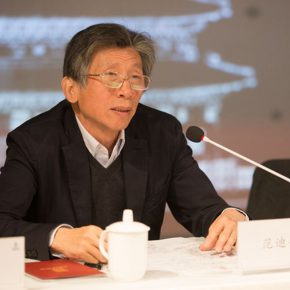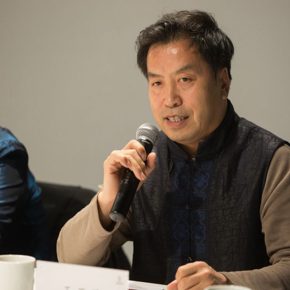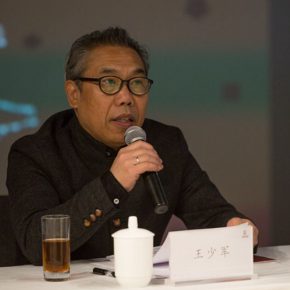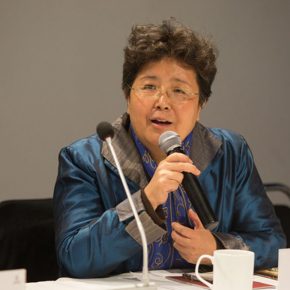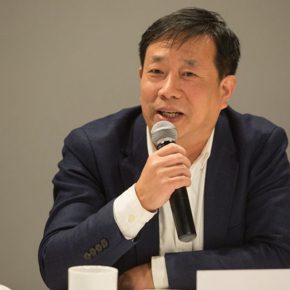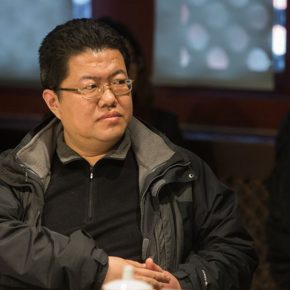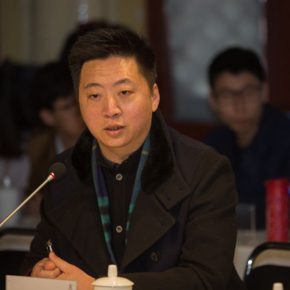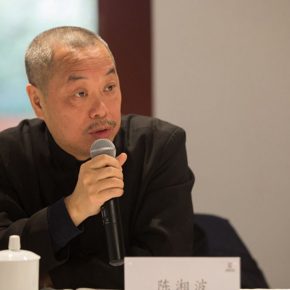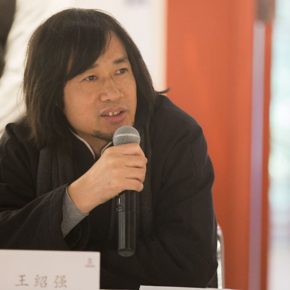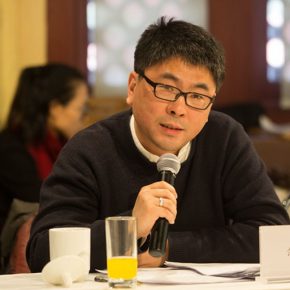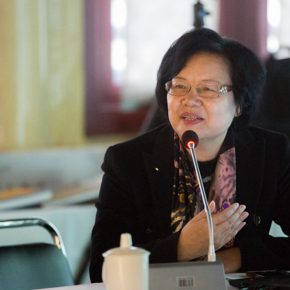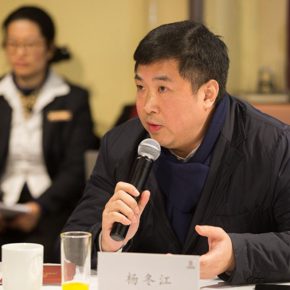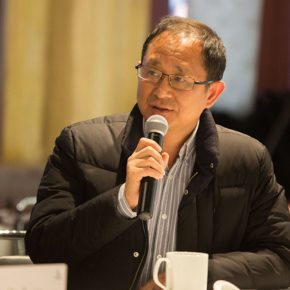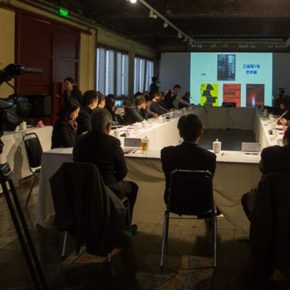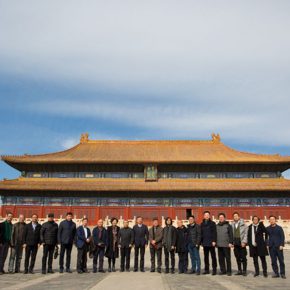
On the occasion of the “Echo of Civilization: Part II Chinese Craftsmen” opened at the Imperial Ancestral Temple on February 28, 2017, it launched a discussion of “Curatorial Vision and Exhibition Form” at the Imperial Ancestral Temple, more than 20 experts from the art museums all over the country gathered to share their operating ideas and classic cases as well as a full exchange and discussion on the academic topic of “Curatorial Vision and Exhibition Form.”
The discussion was organized by Yue Jieqiong and Li Peng, Executive Directors of Ancestral Temple Art Gallery and it was presided over by Tang Bin, Deputy Director of the CAFA Art Museum. Fan Di’an, Honorable Director of the Ancestral Temple Art Gallery and President of the Central Academy of Fine Arts, Wang Yamin, Executive Deputy Director of the Palace Museum, Tian Kai, Director of Henan Museum, Qian Linxiang, Secretary-General of Professional Board of the National Art Museums, Wang Shaojun, Deputy Secretary of the Party Committee of the Central Academy of Fine Arts, An Yuanyuan, Deputy Director of National Art Museum of China, Chen Xiangbo, Director of the Guan Shanyue Art Museum, Ji Shaofeng, Director of Hubei Art Museum, Wang Shaoqiang, Director of Guangdong Museum of Art, Wu Hongliang, Vice President of the Beijing Fine Art Academy, Director of the Art Museum of Beijing Fine Art Academy, Zhou Xujun, Director of Beijing Minsheng Art Museum, Gao Peng, Director of the Today Art Museum, Yang Dongjiang, Deputy Director of the Art Museum of Tsinghua University, Yu Liangfeng, Deputy Director of Zhejiang Art Museum, Wang Yingchuan, Deputy Dean of the School of Plastic Arts, CAFA, Lv Pinchang, Director of the Department of Sculpture, CAFA, Liu Zili, Chairman of Jingdezhen Ceramic Culture Tourism Group attended the discussion.
From the former representation of the top position of ancient Chinese ceremony on civilization to the Working People’s Cultural Palace, the Imperial Ancestral Temple has now become the Ancestral Temple Art Gallery, the changes of this architectural identity and site function is a valuable academic topic in the field of art museums and art exhibitions and Wang Shaojun, Deputy Secretary of the Party Committee of the Central Academy of Fine Arts, Qian Linxiang, Secretary-General of Professional Board of the National Art Museums and An Yuanyuan, Deputy Director of National Art Museum of China respectively delivered a speech on this topic. Yue Jieqiong, Executive Director of the Ancestral Temple Art Gallery directly started with cases to explain the operating methods of the Imperial Ancestral Temple, and shared the curatorial ideas and experiences of many academic exhibitions held in the art gallery since it opened, including “The Temperature of History: CAFA and Chinese Representational Oil Paintings”, “Urtyn Duu from the Prairie: The Communicating Exhibition of Sino-Mongolian Contemporary Fine Arts”, “True Color of Ink Painting: Invitational Exhibition of Contemporary Chinese Painting”, “Crossing Dunhuang”, “Chinese Craftsmen”, and she said it would present “The Idea of Cloth” and China-Ukraine Art Exchange Exhibition.
All the participants are the directors of national well-known art museums and museums, and they have a wealth of planning experience and systematic academic research of exhibitions. Wang Yamin, Executive Deputy Director of the Palace Museum said that, the Palace Museum mainly presented the collections before the Qing Dynasty, and he was currently interested in how to make the collections of the Republic of China interact with the public, and he emphasized the exhibition’s dominant ideology, and it should have a long-term plan for exhibitions. Arbitrarily holding an exhibition is neither conducive to the academic research of the exhibition, nor the brand building of the museum. Wu Hongliang, Director of the Art Museum of Beijing Fine Art Academy and Chen Xiangbo, Director of the Guan Shanyue Art Museum shared a wonderful case in micro analysis and put forward the importance of independent academic character for an exhibition and art museum. Ji Shaofeng, Director of Hubei Art Museum shared a series of “Re-”exhibitions held in the Hubei Art Museum, such as “Re-Ink”, “Re-History”, “Re-Portrait”, Ji Shaofeng said that the idea of “Re-“ was a new reflection on the current art museums, artistic identity and value, aimed at building a modern order for civilization. Tian Kai, Director of Henan Museum said that, compared to the exhibition of art museums, the one that is held in the museum should think about the social and historical impact. Wang Shaoqiang, Director of Guangdong Museum of Art, Zhou Xujun, Director of Beijing Minsheng Art Museum, Gao Peng, Director of the Today Art Museum, Yang Dongjiang, Deputy Director of the Art Museum of Tsinghua University, Yu Liangfeng, Deputy Director of Zhejiang Art Museum shared their own experiences and ideas on research from the perspective of the training of talent in exhibitions, how to activate the traditional and contemporary, the future of the art museum and virtual form. It is a new inspiration for Chinese future art museums and exhibition planning.
Finally, Fan Di’an, President of the Central Academy of Fine Arts offered a conclusion. He said that, the cultural consciousness that emerged from the Chinese art circles since the beginning of the 21st century, a variety of thoughts in the process of globalization had provided us with a basis for the discussion on the links between the ancient and modern in the overall form of Chinese art, while it proposed a the subject of “How to tell Chinese stories to the world, reflecting the cultural subjectivity of Chinese art”, and also prompted us to explore the links between ancient and modern in this time frame. The so-called “curatorial vision and exhibition form” is finding a breakthrough in the key point to link the ancient and modern, curatorial changes led the changes of the exhibition form, for example, creating a scene in the moment to increase the audience’s sense of experience, so that the audience gets more exhibition forms than they have an opportunity to dialogue with the art.
Text by Zhang Wenzhi,?Photo by Hu Sichen/CAFA ART INFO
Translated by Chen Peihua and edited by Sue/CAFA ART INFO


